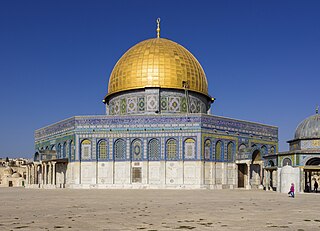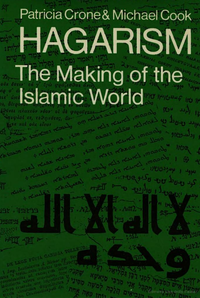
The Temple Mount, also known as Haram al-Sharif, al-Aqsa Mosque compound, or simply al-Aqsa, and sometimes as Jerusalem's holyesplanade, is a hill in the Old City of Jerusalem that has been venerated as a holy site for thousands of years, including in Judaism, Christianity and Islam.

The Dome of the Rock is an Islamic shrine at the center of the Al-Aqsa mosque compound on the Temple Mount in the Old City of Jerusalem. It is the world's oldest surviving work of Islamic architecture, the earliest archaeologically attested religious structure to be built by a Muslim ruler and its inscriptions contain the earliest epigraphic proclamations of Islam and of the Islamic prophet Muhammad.

The Cave of the Patriarchs or Tomb of the Patriarchs, known to Jews by its Biblical name Cave of Machpelah and to Muslims as the Sanctuary of Abraham, is a series of caves situated 30 kilometres (19 mi) south of Jerusalem in the heart of the Old City of Hebron in the West Bank. According to the Abrahamic religions, the cave and adjoining field were purchased by Abraham as a burial plot, although most historians believe the Abraham-Isaac-Jacob narrative to be primarily mythological. The site is considered a holy place in Judaism, Christianity, and Islam.

Islamic–Jewish relations comprise the human and diplomatic relations between Jewish people and Muslims in the Arabian Peninsula, Northern Africa, the Middle East, and their surrounding regions. Jewish–Islamic relations may also refer to the shared and disputed ideals between Judaism and Islam, which began roughly in the 7th century CE with the origin and spread of Islam in the Arabian peninsula. The two religions share similar values, guidelines, and principles. Islam also incorporates Jewish history as a part of its own. Muslims regard the Children of Israel as an important religious concept in Islam. Moses, the most important prophet of Judaism, is also considered a prophet and messenger in Islam. Moses is mentioned in the Quran more than any other individual, and his life is narrated and recounted more than that of any other prophet. There are approximately 43 references to the Israelites in the Quran, and many in the Hadith. Later rabbinic authorities and Jewish scholars such as Maimonides discussed the relationship between Islam and Jewish law. Maimonides himself, it has been argued, was influenced by Islamic legal thought.

Jewish history is the history of the Jews, their nation, religion, and culture, as it developed and interacted with other peoples, religions, and cultures.
Abū Jaʿfar Muḥammad ibn Jarīr ibn Yazīd al-Ṭabarī, commonly known as al-Ṭabarī, was a Persian Sunni Muslim scholar, polymath, traditionalist, historian, exegete, jurist, and theologian from Amol, Tabaristan, present-day Iran. Among the most prominent figures of the Islamic Golden Age, al-Tabari is widely known for his historical works and expertise in Quranic exegesis, and has been described as "an impressively prolific polymath". He authored works on a diverse range of subjects, including world history, poetry, lexicography, grammar, ethics, mathematics, and medicine. Among his most famous and influential works are his Quranic commentary, Tafsir al-Tabari, and historical chronicle, Tarikh al-Tabari.

Jund Filasṭīn was one of the military districts of the Umayyad and Abbasid province of Bilad al-Sham (Levant), organized soon after the Muslim conquest of the Levant in the 630s. Jund Filastin, which encompassed most of Palaestina Prima and Palaestina Tertia, included the newly established city of Ramla as its capital and eleven administrative districts (kura), each ruled from a central town.
Religion in Israel is manifested primarily in Judaism, the ethnic religion of the Jewish people. The State of Israel declares itself as a "Jewish and democratic state" and is the only country in the world with a Jewish-majority population. Other faiths in the country include Islam, Christianity and the religion of the Druze people. Religion plays a central role in national and civil life, and almost all Israeli citizens are automatically registered as members of the state's 14 official religious communities, which exercise control over several matters of personal status, especially marriage. These recognized communities are Orthodox Judaism, Islam, the Druze faith, the Catholic Church, Greek Orthodox Church, Syriac Orthodox Church, Armenian Apostolic Church, Anglicanism, and the Baháʼí Faith.

The History of the Prophets and Kings, more commonly known as Tarikh al-Tabari or Tarikh-i Tabari or The History of al-Tabari is an Arabic-language historical chronicle completed by the Muslim historian Muhammad ibn Jarir al-Tabari in 915 AD. It begins with creation, and charts Muslim and Middle Eastern history from the myths and legends associated with the Old Testament through to the history of the Abbasid era, down to the year 915. An appendix or continuation, was written by Abu Abdullah b. Ahmad b. Ja'far al-Farghani, a student of al-Tabari.

The city of Jerusalem is sacred to many religious traditions, including the Abrahamic religions of Judaism, Christianity and Islam which consider it a holy city. Some of the most sacred places for each of these religions are found in Jerusalem, most prominently, the Temple Mount/Haram Al-Sharif.

Hagarism: The Making of the Islamic World is a 1977 book about the early history of Islam by the historians Patricia Crone and Michael Cook. Drawing on archaeological evidence and contemporary documents in Arabic, Armenian, Coptic, Greek, Hebrew, Aramaic, Latin and Syriac, Crone and Cook depict an early Islam very different from the traditionally-accepted version derived from Muslim historical accounts.

Norman Arthur Stillman, also Noam, is an American academic, historian, and Orientalist, serving as the emeritus Schusterman-Josey Professor and emeritus Chair of Judaic History at the University of Oklahoma. He specializes in the intersection of Jewish and Islamic culture and history, and in Oriental and Sephardi Jewry, with special interest in the Jewish communities in North Africa. His major publications are The Jews of Arab Lands: a History And Source Book and Sephardi Religious Responses to Modernity. In the last few years, Stillman has been the executive editor of the "Encyclopedia of Jews in the Islamic World", a project that includes over 2000 entries in 5 volumes.

Israʼiliyyat are narratives assumed to be of foreign import in many parts of modern Islamic scholarship. Isra'iliyyat are typically said to derive from Jewish sources, but some also sourced from Christian or Zoroastrian tradition. Many Muslim scholars now label Isra'iliyyat as un-Islamic or foreign to Islam, yet they were enthusiastically used by pre-modern scholars.

Ze’ev Maghen is an Israeli scholar. He is a professor of Arabic and Islamic history and chairman of the Department of Middle East Studies at Bar-Ilan University. Maghen is also a senior fellow at the Begin-Sadat Institute for Strategic Studies, as well as the founder of the Middle East and Islamic Studies program at Shalem College in Jerusalem.

Temple denial is the claim that the successive Temples in Jerusalem either did not exist or they did exist but were not constructed on the site of the Temple Mount, a claim which has been advanced by Islamic political leaders, religious figures, intellectuals, and authors.
Judaism's doctrines and texts have sometimes been associated with violence or anti-violence. Laws requiring the eradication of evil, sometimes using violent means, exist in the Jewish tradition. However, Judaism also contains peaceful texts and doctrines. There is often a juxtaposition of Judaic law and theology to violence and nonviolence by groups and individuals. Attitudes and laws towards both peace and violence exist within the Jewish tradition. Throughout history, Judaism's religious texts or precepts have been used to promote as well as oppose violence.

The Islamization of Jerusalem refers to the process through which Jerusalem and its Old City acquired an Islamic character and, eventually, a significant Muslim presence. The foundation for Jerusalem's Islamization was laid by the Muslim conquest of the Levant, and began shortly after the city was besieged and captured in 638 CE by the Rashidun Caliphate under Umar ibn al-Khattab, the second Rashidun caliph. The second wave of Islamization occurred after the fall of the Kingdom of Jerusalem, a Christian state that was established after the First Crusade, at the Battle of Hattin in 1187. The eventual fall of the Crusader states by 1291 led to a period of almost-uninterrupted Muslim rule that lasted for seven centuries, and a dominant Islamic culture was consolidated in the region during the Ayyubid, Mamluk and early Ottoman periods. Beginning in the late Ottoman era, Jerusalem’s demographics turned increasingly multicultural, and regained a Jewish-majority character during the late-19th and early-20th centuries that had not been seen since the Roman period, which largely ended the Jewish presence in the region.

The Abbasid revolution, also called the Movement of the Men of the Black Raiment, was the overthrow of the Umayyad caliphate, the second of the four major caliphates in Islamic history, by the third, the Abbasid caliphate.

Ihsan Abbas was a Palestinian professor at the American University of Beirut, and was considered a premier figure of Arabic and Islamic studies in the East and West during the 20th century. The "author of over one hundred books", during his career, Abbas was renowned as one of the foremost scholars of Arabic language and literature and was a respected literary critic. Upon his death, Abbas was eulogized by University College London historian Lawrence Conrad as a custodian of Arabic heritage and culture, and a figure whose scholarship had dominated the Middle East's intellectual and cultural life for decades.

The history of Jerusalem during the Early Muslim period covers the period between the capture of the city from the Byzantines by the Arab Muslim armies of the nascent Caliphate in 637–638 CE, and its conquest by the European Catholic armies of the First Crusade in 1099. Throughout this period, Jerusalem remained a largely Christian city with smaller Muslim and Jewish communities. It was successively part of several Muslim states, beginning with the Rashidun caliphs of Medina, the Umayyads of Syria, the Abbasids of Baghdad and their nominal Turkish vassals in Egypt, and the Fatimid caliphs of Cairo, who struggled over it with the Turkic Seljuks and different other regional powers, only to finally lose it to the Crusaders.
















